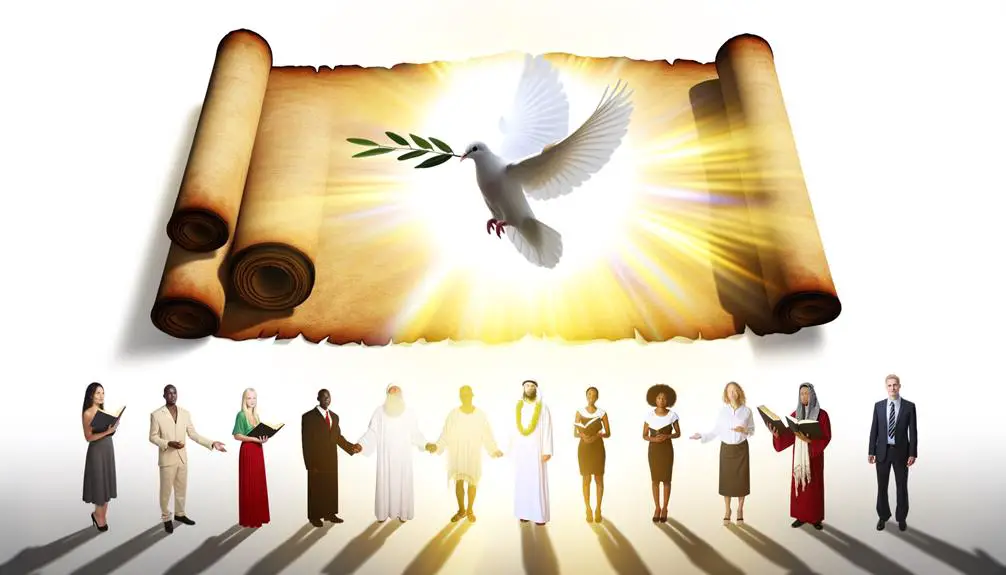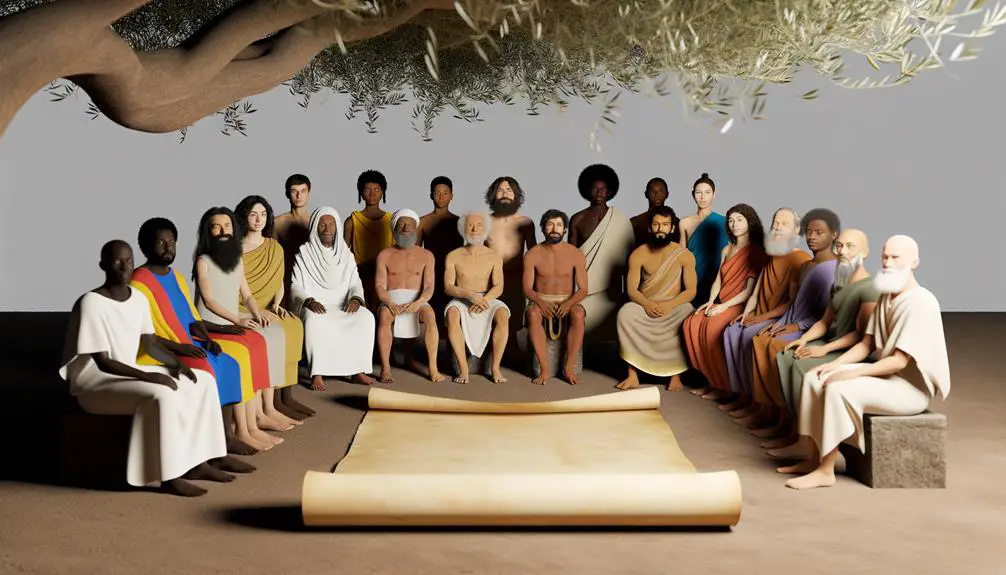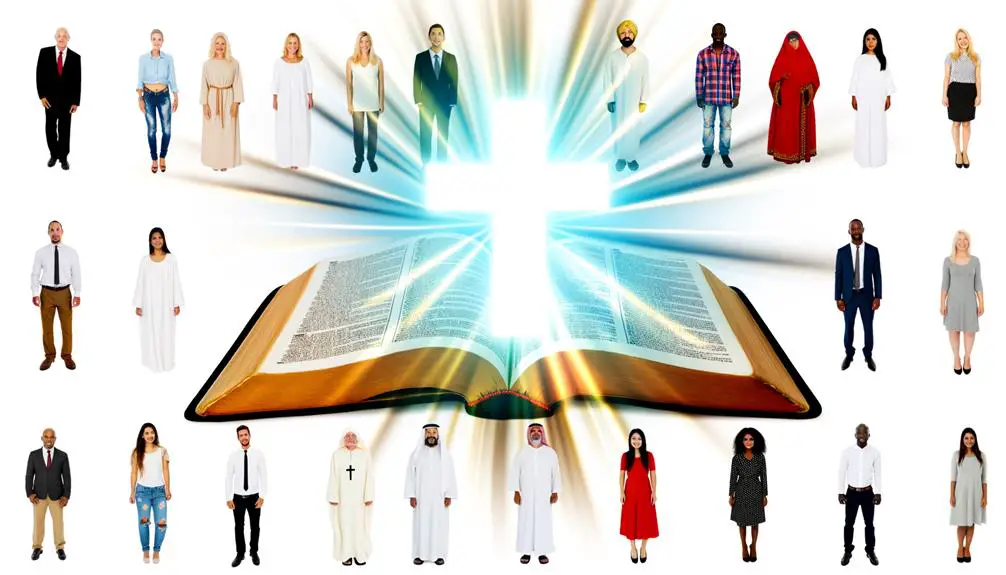Learn about the profound journey of a proselyte in the Bible, where conversion unveils challenges and transformations in faith and identity.

What Does Proselyte Mean in the Bible
It's interesting that you've stumbled upon the term 'proselyte' just as discussions about its biblical significance are becoming more relevant.
In the Bible, a proselyte refers to a person who has converted to Judaism, a journey marked by both spiritual awakening and societal challenges. This term not only encapsulates a transformation but also invites us to explore the nuanced procedures and the profound impact such conversions had on ancient communities.
You'll find that the historical and religious implications of being a proselyte raise questions about identity, belonging, and faith that are still pertinent today. Let's embark on uncovering the layers behind this ancient practice and its echo in modern conversations.
Key Takeaways
- A proselyte is a non-Jewish person who has converted to Judaism, as depicted in the Bible.
- The conversion process involves rituals, teaching on laws, and cultural integration into the Jewish community.
- Biblical examples of proselytes, such as Ruth and The Ethiopian Eunuch, highlight the transformative power of faith across cultural boundaries.
- Modern interpretations of proselytism in the Bible explore the complexities of cultural assimilation and theological debates.
Definition and Origins

In biblical context, a proselyte refers to a non-Jewish individual who's converted to Judaism, embodying a transition deeply rooted in ancient religious practices and cultural assimilation. This term, originating from the Greek word 'proselytos,' meaning 'one who's come over,' highlights the dynamic journey of faith and identity that these individuals undergo. The evolution of language surrounding the concept of proselytism reveals much about the cultural significance and historical context of religious conversion in antiquity.
You'll find that the transformation of the term 'proselyte' over centuries reflects broader shifts in religious, social, and linguistic landscapes. Initially, the process of becoming a proselyte involved comprehensive integration into the Jewish community, including adherence to ceremonial laws, customs, and practices. This not only signified a religious conversion but also a profound cultural assimilation, underscoring the interconnectedness of faith and identity within ancient societies.
Moreover, the linguistic journey of the word 'proselyte' mirrors the evolving attitudes towards conversion and cultural integration. In its earliest uses, it conveyed a sense of voluntary transition, emphasizing the individual's active choice in embracing a new religious and cultural identity. Over time, as the concept of religious conversion gained complexity, the term came to encapsulate the multifaceted nature of this spiritual and societal shift.
Analyzing the term 'proselyte' through the lens of language evolution and cultural significance offers a nuanced understanding of the complexities surrounding religious conversion in biblical times. It underscores the profound impact of cultural and linguistic dynamics on the interpretation and practice of faith, highlighting the rich tapestry of ancient religious traditions and community life.
Biblical References

Turning our focus to the Bible, you'll discover various passages that illuminate the role and significance of proselytes within the scriptural narrative. These references aren't merely incidental; they're woven into the text, highlighting the inclusivity and universal outreach of the faith. By examining the Hebrew terminology and cultural context, you'll gain a deeper understanding of how proselytes were viewed and integrated into the religious community.
The term 'proselyte' itself is rooted in Greek, but its usage in the Bible mirrors the Hebrew concept of a 'ger,' referring to a sojourner or a stranger who's chosen to live among the Israelites, adopting their customs and religion. This integration process isn't depicted as superficial; rather, it underscores a profound transformation and acceptance into the community, both spiritually and socially.
In the Pentateuch, the emphasis on treating the 'ger' with fairness and equity underlines the importance of embracing those who choose to join the Israelite community, reflecting a divine mandate for inclusivity. This theme is echoed in the Prophets and Writings, where the presence of proselytes among the people of Israel serves as a testament to the faith's appeal beyond its ethnic boundaries.
The New Testament further expands on this by illustrating the early Christian community's approach to proselytes. Acts of the Apostles, for instance, mentions proselytes in the context of Pentecost, indicating their active participation in the burgeoning Christian movement.
Through these biblical references, it's clear that proselytes played a pivotal role in the religious life of ancient Israel and the early Christian community, challenging modern readers to consider the enduring implications of inclusivity and conversion within their own faith practices.
Conversion Process

The conversion process for proselytes in biblical times entailed a comprehensive transformation, encompassing both spiritual and communal integration. This journey wasn't merely about adopting new beliefs; it involved navigating through ceremonial rites and overcoming cultural barriers, marking a profound transition into a new way of life.
Stage |
Description |
|---|---|
Ceremonial Rites |
Proselytes underwent specific rituals, including baptism, to symbolize purification and rebirth into their new faith. |
Instruction |
They received extensive teaching on the laws and traditions, ensuring full understanding and commitment to their adopted beliefs. |
Cultural Integration |
Embracing the community's customs and overcoming existing cultural barriers were crucial for genuine acceptance and integration. |
Formal Acceptance |
The final step was formal recognition by the religious community, signifying the successful completion of the conversion process. |
This structured approach underscored the importance of both the spiritual and societal aspects of conversion. It wasn't simply about personal faith; it required a visible and tangible commitment to the community's ways of life. The ceremonial rites, for instance, were not just symbolic gestures but pivotal moments of transformation, publicly marking the individual's transition into their new faith community. Similarly, overcoming cultural barriers was essential for ensuring that the integration was not superficial but rooted in genuine understanding and respect for the community's traditions and values. This dual focus on both the spiritual and communal facets highlights the multifaceted nature of conversion, making it a deeply transformative experience for proselytes.
Social and Religious Impact
You must consider the complex dynamics of community integration challenges and spiritual identity shifts when analyzing the social and religious impact of proselytes in biblical contexts.
These elements not only influenced the individual's journey but also shaped the broader community's response to religious conversion.
Understanding these factors provides insight into the multifaceted role of proselytes within ancient religious communities.
Community Integration Challenges
Proselytes, upon integrating into their new religious communities, often face significant social and religious challenges that can impact both their personal identity and the cohesion of the community at large. Key issues include:
- Cultural assimilation struggles, as they navigate the complex terrain of adopting new customs while retaining aspects of their original identity.
- Language barriers, which can hinder full participation in religious services and community life.
- Social exclusion or skepticism from longer-standing community members, wary of the newcomers' commitment and understanding.
- The pressure to rapidly absorb and adhere to a plethora of religious laws and practices, which can be overwhelming.
These challenges require careful navigation to foster a sense of belonging and acceptance for both the individual and the community.
Spiritual Identity Shifts
Adopting a new faith often necessitates profound shifts in spiritual identity, impacting both the individual's sense of self and their relationships within the community. This transition isn't merely about changing religious affiliations but involves deep identity formation and belief adaptation.
Through the lens of a proselyte's journey, these shifts are emblematic of larger social and religious dynamics at play. As you navigate this path, the ways in which you understand and express your spirituality undergo significant transformation.
This process, while deeply personal, also has communal repercussions, influencing perceptions and interactions within your new spiritual circle. The interplay between personal belief adaptation and communal expectations underscores the complexity of spiritual identity shifts, highlighting both the challenges and enrichments these changes bring to one's faith journey.
Famous Biblical Proselytes

You'll find that the Bible mentions several proselytes who played pivotal roles in religious narratives, each bringing unique stories of conversion and faith. These individuals' journeys from outsiders to embraced members of the faith community highlight the complex interplay of cultural, social, and spiritual elements in biblical times.
Notable Proselytes Overview
Several figures in the Bible stand out as notable proselytes, having embraced new religious beliefs with profound implications for their lives and legacies. Their stories not only highlight the transformative power of faith but also underscore the themes of Gentile inclusion and cultural adaptation within the religious narrative. Here are four such individuals:
- Ruth: A Moabite woman who, through her loyalty and conversion, becomes an exemplar of faith and the great-grandmother of King David.
- Naaman: A Syrian commander whose leprosy is cured by Elisha, leading to his conversion.
- The Ethiopian Eunuch: An early example of Gentile inclusion in Christianity, baptized by Philip.
- Cornelius: A Roman centurion whose conversion marks a pivotal moment for the early Christian church, embodying the breaking down of ethnic barriers.
These proselytes exemplify the rich tapestry of faith, showing how belief transcends cultural and ethnic boundaries.
Conversion Stories Highlighted
Exploring the conversion stories of notable biblical proselytes offers insights into the dynamics of faith and identity in ancient religious contexts. These narratives, richly embedded with cultural influences, shed light on how individuals transcended their original beliefs to embrace a new faith tradition.
Through skillful narrative techniques, the Bible presents these transformations in a manner that highlights the complexity of religious conversion. It's not merely about changing one's religious affiliation; it's a profound journey influenced by personal conviction, divine encounters, and societal pressures.
Modern Interpretations

Modern interpretations of the term 'proselyte' in biblical texts reveal a nuanced understanding of religious conversion and identity within early Christian and Judaic contexts. Scholars have increasingly focused on how these historical conversions underscore the complexities of cultural assimilation and spark theological debates. This attention to detail reflects a broader scholarly endeavor to uncover the multifaceted nature of ancient religious practices and beliefs.
When you delve into the modern interpretations, several key themes emerge:
- Cultural Assimilation: Proselytes in the Bible often navigated the challenging waters of integrating into a new religious community while retaining elements of their original cultural identity. This process wasn't merely religious but also deeply social and cultural.
- Theological Debates: The conversion of proselytes sparked significant theological discussions among early Christians and Jews. Questions about the necessity of circumcision, adherence to dietary laws, and the role of tradition versus faith in salvation were central.
- Identity Formation: For proselytes, conversion was a transformative process that redefined their social and spiritual identities. This transformation was both personal and communal, influencing community dynamics and religious practices.
- Scriptural Interpretations: Modern scholars analyze how scriptural texts regarding proselytes were interpreted and reinterpreted over time, reflecting changing attitudes towards conversion, community boundaries, and religious identity.
Through these lenses, modern scholarship provides a rich, layered understanding of the term 'proselyte.' This analysis not only sheds light on ancient religious dynamics but also offers insights into the ongoing nature of religious conversion and identity formation.
Challenges and Controversies

While the modern interpretations of 'proselyte' enrich our understanding of ancient religious dynamics, they also introduce a range of challenges and controversies that merit closer examination. You'll find that language barriers and cultural assimilation are at the heart of these issues, affecting both the integration of proselytes and the broader community's reception of them.
Challenge/Controversy |
Description |
Impact |
|---|---|---|
Language Barriers |
Proselytes often faced difficulties understanding and communicating in the language of their new religious community. |
This could lead to misinterpretations of religious texts and practices. |
Cultural Assimilation |
The expectation for proselytes to fully assimilate into their new religious culture sometimes clashed with the desire to retain aspects of their original identity. |
Tension between preserving personal heritage and embracing a new religious identity. |
Community Reception |
Existing members of the religious community sometimes viewed proselytes with suspicion or as inferior. |
This could result in social stratification within the religious community, affecting unity and cohesion. |
You're dealing with a complex interplay of factors when examining the challenges and controversies surrounding proselytes. Language barriers not only hindered basic communication but also affected deeper theological understanding and participation in rituals, potentially isolating proselytes. Meanwhile, the push for cultural assimilation posed dilemmas for those trying to navigate the balance between their past and present identities, often exacerbating feelings of alienation.
Furthermore, the reception of proselytes by established community members could vary widely, from welcoming integration efforts to outright resistance, reflecting broader societal attitudes towards outsiders and the tension between purity and inclusivity within religious contexts.
Frequently Asked Questions
How Did the Role and Perception of Proselytes Change From the Old Testament to the New Testament?
In transitioning from the Old to the New Testament, you'll notice a shift in the role and perception of proselytes. Initially seen under the lens of covenant significance, their acceptance hinged on strict adherence to Jewish laws and rituals.
However, the New Testament introduces a pivot in conversion dynamics, emphasizing faith in Jesus Christ over ritualistic practices. This evolution reflects a broader inclusivity, marking a significant theological and social shift in early Christian communities.
In What Ways Did Proselytes Contribute to the Spread of Early Christianity Outside of the Jewish Community?
In the early tapestry of Christianity, proselytes were pivotal threads weaving through the fabric of cultural integration, significantly enhancing the social impact of the faith beyond Jewish borders. They didn't just bridge communities; they enriched them, introducing new perspectives and practices.
Their contributions, deeply analytical and scholarly in nature, facilitated a broader acceptance and understanding of Christian doctrines, objectively expanding the religion's reach and influence among diverse populations, fostering an inclusive, global community.
Are There Any Specific Rituals or Ceremonies That Were Unique to Proselytes' Acceptance Into the Jewish Faith That Differed From Standard Practices?
Yes, the conversion process for proselytes into the Jewish faith involved unique rituals with deep ritual significance.
You'd find that these ceremonies differed markedly from standard practices, including immersion in a mikveh (ritual bath), circumcision for males, and a specific offering in the Temple.
These steps were meticulously designed to symbolize a complete spiritual transformation and acceptance into the Jewish community, setting apart proselytes' initiation from other religious or cultural entry rites.
How Did the Early Christian Church Reconcile the Inclusion of Gentile Proselytes With Jewish Laws and Customs?
You might think reconciling Gentile integration with Jewish laws was seamless, but it sparked heated debates within the early Christian church.
The Apostles, particularly Paul, navigated this cultural assimilation by emphasizing faith in Jesus over adherence to Jewish customs, as seen in the Council of Jerusalem.
This approach allowed for a broader inclusion of Gentiles, sidestepping strict Jewish rituals, and laying groundwork for a more universally accessible Christian faith.
What Are the Parallels and Differences Between Ancient Biblical Proselytism and Modern Missionary Work in Various Religious Traditions?
You're exploring how ancient biblical proselytism compares with today's missionary efforts across religions. Key parallels include a focus on cultural adaptation and the embracing of religious syncretism to some extent.
Differences lie in methodologies and technologies used in outreach. Ancient efforts were more personal and localized, while modern missions utilize digital platforms for global reach.
Both, however, strive for growth in faith communities, adapting methods to cultural contexts to achieve their spiritual objectives.
Conclusion
In your journey through the biblical landscape, you've come to understand that a proselyte isn't merely a convert; they embody the transformative power of faith.
Like a seed sown in fertile ground, each proselyte grows, bridging worlds and weaving new tapestries of belief. This evolution, though fraught with challenges, illuminates the enduring human quest for spiritual belonging.
Analyzing their stories is akin to tending a garden, revealing the intricate interplay of identity, belief, and community in the fabric of religious history.



Sign up